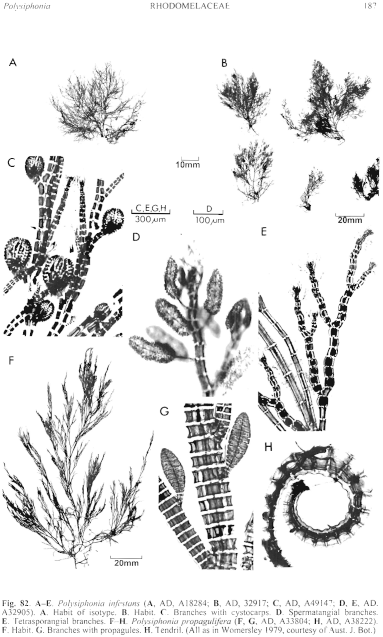|
|
|
|
|
|||||||||||
|
Electronic Flora of South Australia Species Fact Sheet
Phylum Rhodophyta – Family Rhodomelaceae – Tribe Polysiphonieae
Thallus (Fig. 82F) brown-red, 6–22 cm high, with slight prostrate parts attached by rhizoids and also with recurved tendrils (Fig. 82H) from lower parts of the thallus; branching profuse, irregularly lateral and fastigiate above from percurrent main axes, partly denuded below; attachment by rhizoids; substrate unknown. Structure. Basal prostrate axes 500–800 µm in diameter with segments L/D 0.3–0.7, with unicellular rhizoids cut off from the pericentral cells; lower erect branches 300–600 µm in diameter with segments L/D 0.5–0.8 (–1), decreasing gradually to about 200 µm in diameter with segments L/D 0.3–0.5 in lesser branchlets and then tapering evenly to pointed, straight, apices; apical cells small, trichoblasts slender and apparently readily caducous; branches apparently replacing trichoblasts, with a few cicatrigenous branches below. Pericentral cells 4, square to slightly elongate in surface view of lower parts and upper branches, to twice as long as broad in mid parts of main branches, ecorticate; trichoblasts or scar cells present on every segment, with a divergence of 1/4, relatively slender. Rhodoplasts discoid, scattered or in chains. Tendrils (Fig. 82H) present on lower parts of thallus, developed from the terminal 20–30 segments of a branch by enlargement of pericentral cells on one side of branch; rhizoids often developed from pericentral cells on the concave side. Propagules (Fig. 82G) frequent, developing cicatrigenously, borne on a short stalk 4–5 segments long, elongate-ovoid with a rounded apex, 400–500 µm long by 170–250 µm in diameter, with usually 9–12 segments and the 4 pericentral cells slightly broader than long, the junctions slightly alternately staggered as seen in surface view.
Reproduction: Reproduction unknown, apart from propagules.
Type from off Troubridge I., S. Aust., 23 m deep (Shepherd, 4.ii.1969); holotype in AD, A33804.
Distribution: Only known from the type and from Investigator Strait, S. Aust., 34 m deep (Watson, 20.i.1971; AD, A39218) and 33 m deep (Watson, 24.i.1971; AD, A38222) and Penneshaw reef, Kangaroo I., S. Aust., 11 m deep (Lavers, 5.xi.1999; AD, A68927).
Taxonomic notes: Although normal reproductive structures are unknown, P. propagulifera appears to be a distinctive species, restricted to deep water. It is marked by its dimensions and very short segments throughout with pericentral cells mostly square in surface view, and the distinctive propagules. However, collections of a seemingly distinct species, also from deep water and which bear propagules are known from Satellite I., D'Entrecasteaux Ch., Tas., 12 m deep (Shepherd, 17.ii.1972; AD, A41654) (see Womersley 1979, p. 478) and from 3–4 km E of Lakes Entrance, Vic., 20–30 m deep (G. North, 6.xii.1997; AD, A6774). These specimens, which appear similar, are distinctly more slender than P. propagulifera and the propagules are about half as long and broad as those of the latter. Further collections of such plants may permit description of a new species.
Tuberous structures which may act as propagules have been recorded in P. tuberosa Hollenberg (1968a, p. 93, fig. 39), and Kapraun (1977) has described specialised asexual propagules, borne on the trichoblasts, in P. ferulacea J. Agardh.
References:
HOLLENBERG, G.J. (1968a). An account of the species of Polysiphonia of the central and western Tropical Pacific Ocean. 1. Oligosiphonia. Pacif. Sci. 22, 56–98.
KAPRAUN, D.F. (1977). Asexual propagules in the life history of Polysiphonia ferulacea (Rhodophyta, Ceramiales). Phycologia 16, 417–426.
WOMERSLEY, H.B.S. (1979). Southern Australian species of Polysiphonia Greville (Rhodophyta). Aust. J. Bot. 27, 459–528.
The Marine Benthic Flora of Southern Australia Part IIID complete list of references.
Publication:
Womersley, H.B.S. (24 February, 2003)
The Marine Benthic Flora of Southern Australia
Rhodophyta. Part IIID. Ceramiales – Delesseriaceae, Sarcomeniaceae, Rhodomelaceae
Reproduced with permission from The Marine Benthic Flora of Southern Australia Part IIID 2003, by H.B.S. Womersley. Australian Biological Resources Study, Canberra. Copyright Commonwealth of Australia.
Illustration in Womersley Part IIIA, 2003: FIG. 82 F–H.

Figure 82 enlarge
Fig. 82. A–E. Polysiphonia infestans (A, AD, A18284; B, AD, 32917; C, AD, A49147; D, E, AD, A32905). A. Habit of isotype. B. Habit. C. Branches with cystocarps. D. Spermatangial branches. E. Tetrasporangial branches. F–H. Polysiphonia propagulifera (F, G, AD, A33804; H, AD, A38222). F. habit. G. Branches with propagules. H. Tendril. (All as in Womersley 1979, courtesy of Aust. J. Bot.)

|
Email Contact: State Herbarium of South Australia |

|